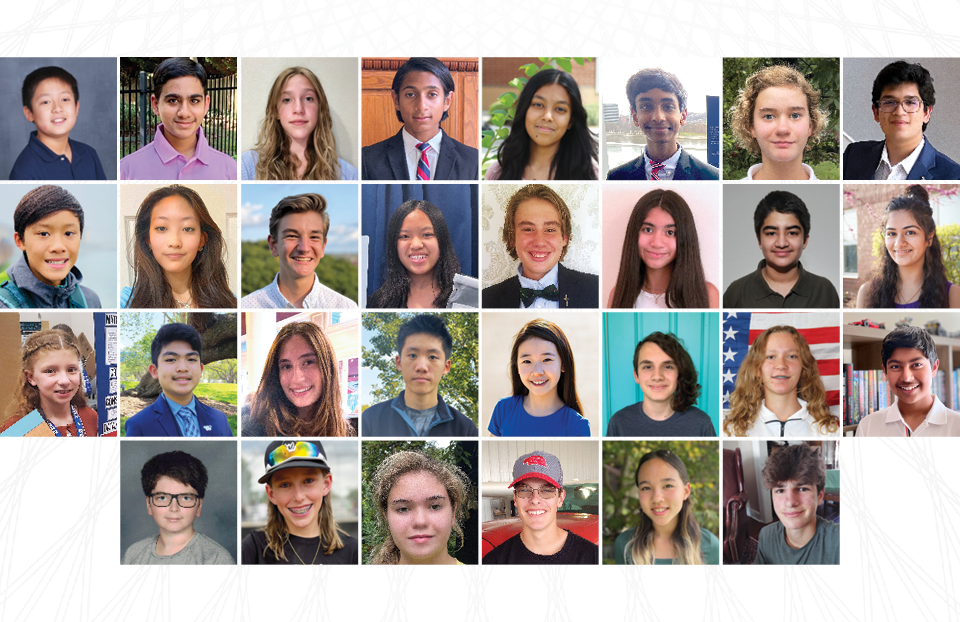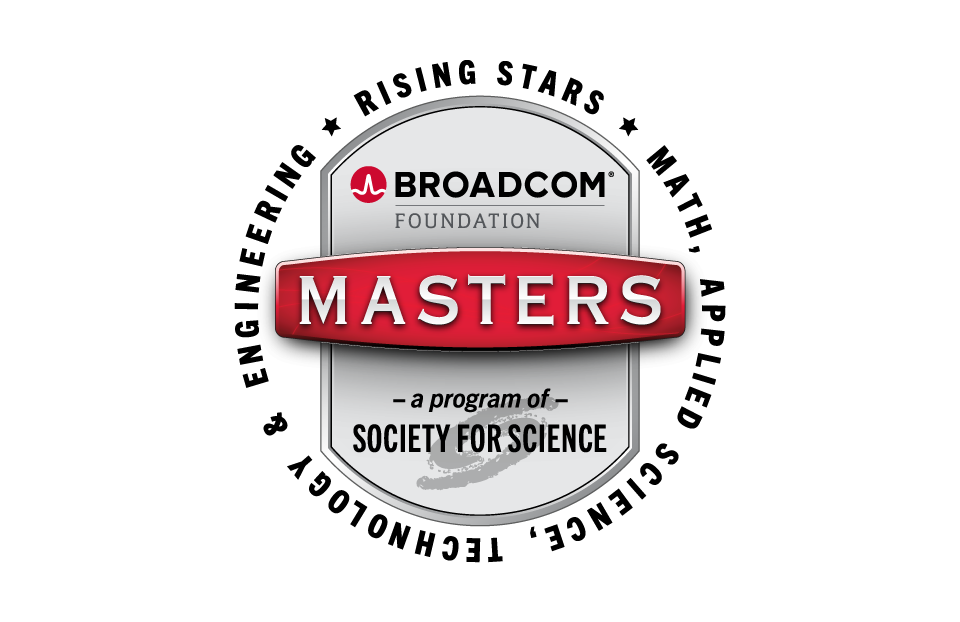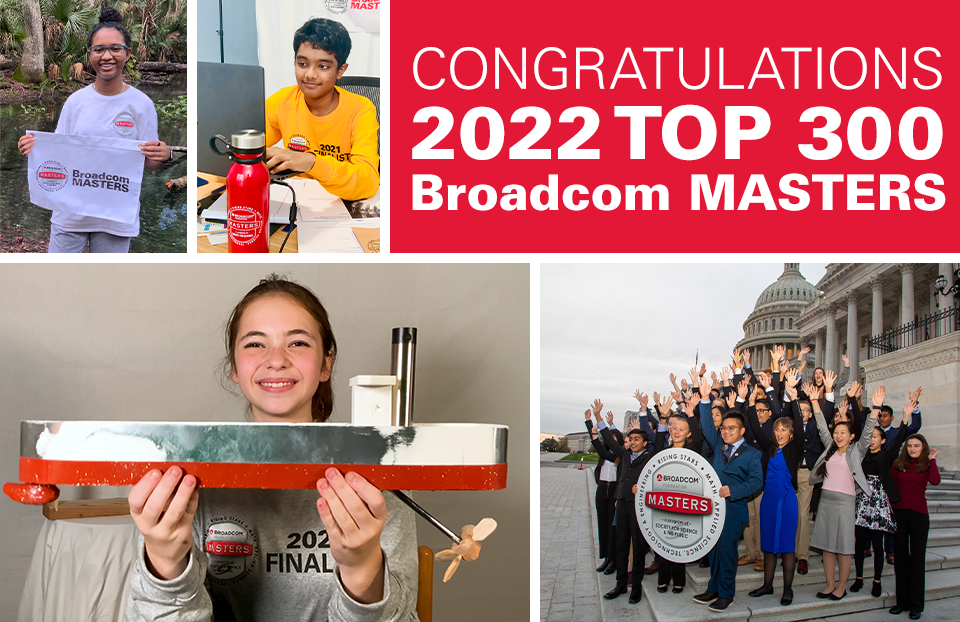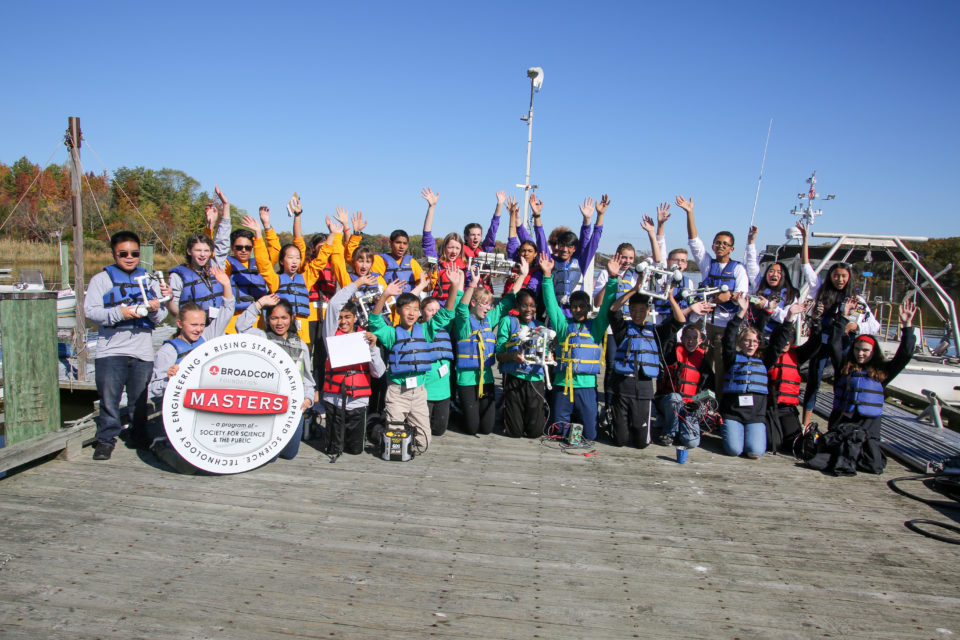2022 Broadcom MASTERS Finalists
Society for Science and Broadcom Foundation are proud to announce the 30 finalists in the 2022 Broadcom MASTERS® — the nation’s premier STEM competition for middle school students. The finalists will travel to Washington, DC from October 28 – November 2 to participate in the finals week of the competition. Each student will be judged on both their science research projects as well as their demonstration of collaboration and critical thinking skills during team challenges, emphasizing the importance and value of teamwork in STEM fields.
All finalists receive a $500 cash award and will compete for over $100,000 in prizes.
View the Press ReleaseMeet the 2022 Finalists!
Thomas Aldous
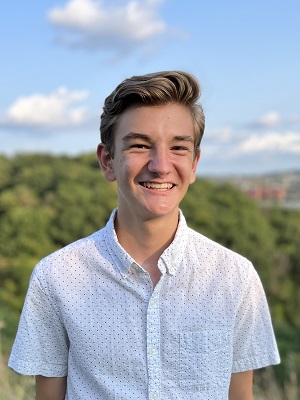
8th Grade, Colfax K-8
Pittsburgh, Pennsylvania
Remote Rescue Robot: Robotic Hand Controlled by Human Motion
Project Background: Thomas wanted to invent an inexpensive robotic hand. Ideally, people could use it in situations that might be dangerous for humans. Some human-controlled robots have already been used for search and rescue work and other risky tasks, he notes. However, they can be very expensive so, the financial losses can be big if robots are damaged or destroyed in the field. “Another issue is that these robots are not as easy to control as if the human were actually there,” Thomas says. He wanted controls for his robotic hand to be simple and intuitive. When a human moved their hand, Thomas wanted his robotic hand to mimic the motions.
Tactics and Results: Thomas attached six strings from spools to a pre-made utility glove’s fingertips. Each spool had a potentiometer attached to it. Those are devices that can vary their resistance to an electric current. That resistance would change as someone moved each finger. “Using a microcontroller, I can read this resistance as an integer,” Thomas says. His control board for the glove had a microcontroller to process data from the potentiometers. Other parts included a transceiver to send data to the robotic hand. Thomas used 3D printing to make the hand and he assembled the hand with servomotors. Those are a type of actuator — a device that provides power to make something happen. When servomotors move a machine’s parts, they can control the angle, position and speed precisely. The hand also had a microcontroller and transceiver to communicate with the glove. Thomas then wrote computer code to convert the values for each finger’s position on the glove into outputs for the servomotors controlling the robotic hand’s fingers. He calculated the latency, or delay, for the robotic hand’s movements at about 14 milliseconds. The combined cost for the hand and glove came to $103.
Other Interests: “I enjoy being able to learn more about the world, and reading is a great way to do that,” Thomas says. He enjoys running, crew and soccer. Individual sports help him clear his mind, he says. He often runs and rows with his dad, too. Thomas also plays the piano. He does engineering projects as a hobby and hopes to become a mechanical engineer. “I have always enjoyed constructing things, and I would love to continue that into my career,” he says.
Tate Baum
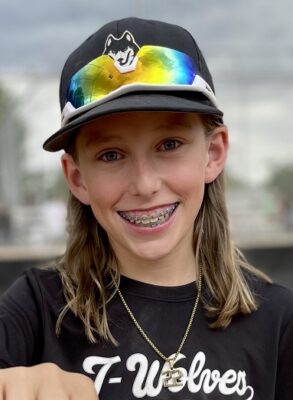
6th Grade, Edgemont Elementary
Provo, Utah
Throwing a Curve Like Kershaw
Project Background: “I wanted to learn the physics behind throwing a curveball so I could throw mine with more movement and break,” says Tate. A curveball pitch has a strong downward spin. That makes it drop and veer as the ball nears home plate. Last year he received a Diamond Kinetics PitchTracker baseball as a gift. Sensors within the ball provide data about pitches as the ball is thrown. The ball sends that information to a smartphone app. The data tell Tate about the pitches’ movement when it’s thrown. Data from the ball’s sensors also tell its speed and the rate, direction and efficiency of its spin from the pitch. Professional pitchers track those same sorts of data, he notes.
Tactics and Results: “When a baseball travels through the air, it experiences three main forces: gravity, drag and the Magnus force,” Tate says. As a spinning object travels through a fluid, such as air, the Magnus force deflects it from the path it would otherwise follow. In baseball, that makes a spinning ball curve or ‘break’ as it travels to the catcher. Tate threw 34 curveball pitches with the PitchTracker ball. For each pitch, he collected data on the ball’s speed, spin direction, spin efficiency, spin rate and vertical break. He made scatterplots to see the relationships between the pitches’ vertical break and each of the other variables. He also used a statistical tool called regression analysis. It let him account for the combined impact of the independent variables on his pitches’ vertical break. The factors that helped his pitches have more vertical break were a lower speed, higher spin rate, more spin efficiency and a spin direction closer to straight down. “I plan to go through a similar process to learn how to better throw some of my other pitches as well,” he says.
Other Interests: Tate is interested in becoming a baseball statistician. “It would be fun and I like statistics,” he says. Last year his baseball team won a tournament, beating a very good team for the championship. His other sports activities include basketball, tennis, skiing and mountain biking. “This year I also learned how to play the trumpet and played in the school band,” he adds.
Dhroov Bharatia
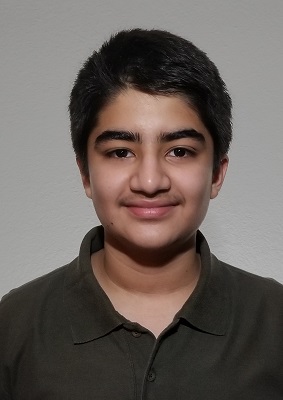
8th Grade, Wilson Middle School
Plano, Texas
QuakeWake: AI to the Rescue
Project Background: More than 2,200 people died when an earthquake hit Haiti in 2021 and earthquakes killed many more thousands of people in the decade before that. Dhroov wanted to help prevent more loss of life, “I found that early earthquake warning systems (EEW) detect earthquakes using seismometers,” he says. Those instruments detect and record movements of the ground. However, they also can be very expensive and don’t provide complete coverage for places that may get earthquakes, says Dhroov. In contrast, smartphones seem to be almost everywhere. The phones have devices called accelerometers that measure vibrations or changes in the rate of movement. Dhroov wondered if data from the devices could be used to warn people about earthquake threats.
Tactics and Results: Dhroov calls his system QuakeWake. He used information from two databases to train a neural network to recognize representative earthquake signals. He used additional data from those sources to make sure the approach worked. He also wrote an algorithm to limit a phone’s follow-up actions for everyday movement patterns. That reduced the drain on his phone battery. In Dhroov’s design, phones in the QuakeWake network would send data to a cloud-based server. The system would analyze the data to see if an earthquake was happening and it would gauge where danger might strike. It could then warn people in the network. Dhroov used parts from an old 3D-printer to make a device that simulates earthquake movements. He then tested how well his system could distinguish likely earthquakes from other shaking. Based on the results, he estimates that QuakeWake could give people between 90 and 190 seconds of warning time before strong earthquake waves hit. The system also could warn if ground movements might have made a building unsafe. A separate device mounted on a building could improve those warnings, he says.
Other Interests: “Playing and composing music helps me relax and channel my creativity in a unique, beautiful way,” Dhroov says. He plays the saxophone, guitar and piano. Dhroov also enjoys debate and mock trial competitions, and he won 4th and 14th place in the Scripps National Spelling Bee in 2021 and 2022. He stays active with basketball, swimming, tennis and martial arts. He plans to become a computer scientist and says, “my dream has always been to help people through science and technology.”
Ankit Biswas
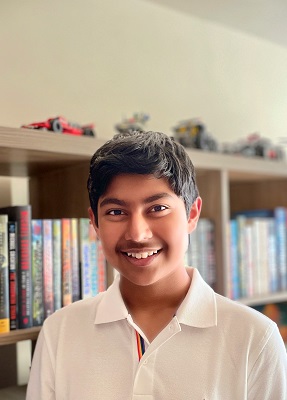
8th Grade, Metrolina Regional Scholars Academy
Charlotte, North Carolina
A Novel LP-Based Approach To Mitigating Launch Vehicle CO2 Emissions
Project Background: Ankit watched the launch of NASA’s Perseverance Mars rover two years ago, and he was fascinated. “As the rocket rose high into the sky, the murky gray plumes swung like a tail beneath it,” he recalls. He began thinking about the environmental effects of emissions from that and other rockets. Fuels that power the rockets can release huge amounts of greenhouse gases and greenhouse gases drive human-caused climate change. Ankit wanted to cut carbon dioxide emissions from rocket launches by at least a quarter over the next ten years. At the same time, he wanted to maximize how much weight any launched rockets could carry, also known as the payload. The work could help shape guidelines for the space industry in the near future, he thinks.
Tactics and Results: Ankit got data on past rocket launches and looked up the launch emissions from different types of rockets. The information let him calculatethe yearly carbon dioxide emissions for launches from 2003 to 2019. Making rockets gives off greenhouse gases, too. Rockets contain lots of aluminum and smelting one metric ton of aluminum releases an average of 11 metric tons of carbon dioxide, Ankit notes. He used that figure and data on rockets’ weight to estimate carbon dioxide emissions from production. Ankit figured out the likely trends for launch and production emissions over the next decade. Next, he needed the best way to cut emissions while sending the most weight into space. To figure that out, he used the simplex algorithm. It’s often used in computer programming for optimization problems. Basically, it looks for the best solution that will maximize or minimize the results of functions involving multiple variables. Based on his work, Ankit figures the best mix will be to launch 41 rockets each year with petroleum fuel and 11 with cryogenic fuel. The rockets’ average payload should be 29 metric tons.
Other Interests: Ankit enjoys writing fiction and poetry. “I also possess a deep love for reading,” he says. He stays active with karate, tennis and swimming. He sings in choir and plays the piano and bass clarinet. His other activities include chess, Quiz Bowl, helping at a food program for people in need, and more. He is interested in a career in astrophysics. “The incomprehensible scale of the universe fascinates me,” he says.
Madison Checketts
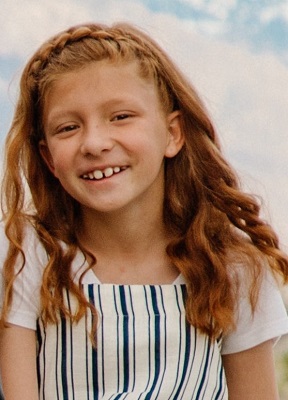
6th Grade, Hidden Hollow Elementary
Eagle Mountain, Utah
The Eco-Hero
Project Background: “I was having fun on the beach in sunny California when I noticed the many plastic water bottles cluttering the sand and ocean,” Madi says. That experience spurred her to learn more about the broad problems of plastics pollution. According to some estimates, plastic kills roughly a million seabirds each year., Plastic pollution kills sea turtles as well. Research also has linked some common chemicals in plastics to a variety of health problems. “Plastic water bottles help contribute to the pollution and the destruction of the environment,” says Madi. She looked for a way to cut down on waste from plastic water bottles, so she invented an edible water bottle.
Tactics and Results: Others have tried making an edible water bottle but Madi wanted her water bottle to be bigger, stronger and last longer. Her design uses a flexible membrane and is made with a process called reverse spherification. The process uses a chemical reaction between two chemicals that are often used as food additives. One chemical is a salt called calcium lactate and the other is a natural polymer from brown algae, called sodium alginate. “When mixed, the alginate attracts to the calcium ions and they form a cross link, which forms a membrane and traps the liquid,” Madi explains. “Once the membrane has formed with the liquid inside, it is taken out and rinsed in a water bath to stop the process.” Madi tested different concentrations and temperatures to get the best results. She also tested different concentrations of a thickening agent called xanthan gum. That helped make the membrane stronger, but the taste was horrible. A teaspoon of lemon juice improved the taste and helped the membrane last longer. Her final prototype held about 200 ml (3/4 cup) of water. It cost about $1.20 to make and lasted about two weeks when kept in a refrigerator.
Other Interests: Madi has been playing soccer since she was four years old. She also enjoys cooking. “I always receive a delicious reward when I am done!” she says. She likes making bracelets and other jewelry as well. Madi hopes to become a pediatric nurse one day. “I feel that helping people when they are sick or hurt can help make them happier even though they are going through a hard time,” she says.
Marco Alexander Chua
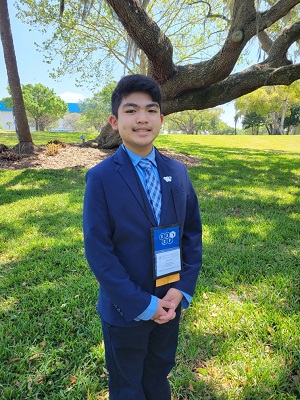
7th Grade, Saint Paul’s Catholic School – Riverside
Jacksonville, Florida
Wave Force Dissipation: Testing the Effectiveness of Geometric Shapes in Wave Breaking
Project Background: “In September 2017, Hurricane Irma brought record flooding to my home city of Jacksonville,” says Marco. Flooding caused damage as streets turned into rivers and millions of homes and businesses lost power. Hurricanes typically strike Florida from June through November each year. A large majority of the state’s people live in coastal areas and those people and their property are especially at risk from storm surges during hurricanes and other extreme weather. Marco wanted to do something to reduce the potential harm. “By using effective flood barriers, the impact of coastal flooding can be lessened,” he says.
Tactics and Results: Marco experimented with different shapes to see which would work best to reduce flooding from large sea waves. To do that, he designed a wave tank. He hooked up a servomotor to a paddle that would make waves in the tank. The device let him control the speed and torque of the paddle. That way, the waves made by the paddle were consistent. Marco put a concrete plank near the other end of the tank. It represented the land area along a coast. Marco first measured how much water from the artificial waves went into the collection area when there was no flood barrier on top of the concrete plank. Then he tested flood barriers made of cubes, cylinders and spheres. Each barrier had three rows of the shapes on top of the concrete plank and all of the shapes were made of the same material, concrete. “The cubes blocked statistically significantly more water than the other two shapes,” Marco reports. The cylinders and spheres worked better than nothing at all, but neither of those shapes was significantly better than the other.
Other Interests: “For as long as I can remember, I’ve been drawn to areas and activities that are related to water, such as swimming, aquatic life, and the beach,” he notes. He hopes to become a marine biologist. “I hope to be part of discovery efforts and uncover new marine species,” he says. “I wish to learn more about the life cycles of marine animals and their migration patterns.” Marco stays active by playing basketball. He also plays the piano and sings in choir.
Shaunak Dalal
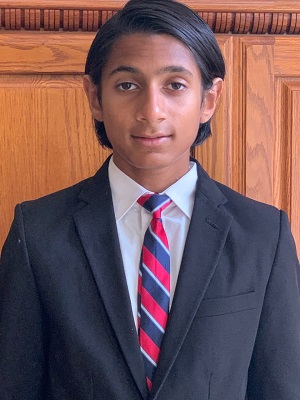
8th Grade, Hershey Middle School
Hershey, Pennsylvania
Effect Upon Closure Dynamics of the Application of Weak Acids to the Pulvinus of the Venus Fly Trap
Project Background: Shaun’s project stems from his interest in two areas of science: environmental studies and neuroscience. Plants respond to stimuli in their environment, yet they don’t have a brain or central nervous system. Shaun was especially curious about the Venus fly trap, which is native to acidic, swampy areas in the southeastern United States. The carnivorous plant traps insects or other small animals for supplemental nutrition with specialized hinged leaves. When something touches sensitive hairs on the edges, the stimulus causes sodium ions to flow. That triggers electrical signals, and those signals make the trap snap shut. Shaun wondered if weak acids might affect the process.
Tactics and Results: Shaun’s experiment used four Venus fly trap plants with a total of 18 traps. He first established the baseline closure time without any treatment. To do that, he stimulated the traps with a toothpick. Video from a phone camera let him time how quickly each trap closed. Most traps opened again a day or so later. Then Shaun poured 10 milliliters (2 teaspoons) of a 5-percent citric acid solution onto each plant. After 90 minutes, he timed the traps’ closures again. He gave the plants four days to recover, then did the same procedure with a five-percent acetic acid solution. After the citric acid application, the average closing times decreased slightly, Shaun reports. The acetic acid solution did not seem to affect the closing times. Overall, Shaun found it took longer for traps to reopen after treatment with the acids. He also noticed some harm to plants. A larger sample size with more plants and separate groups for each acid might be helpful for future work, he thinks. Shaun sees the Venus fly trap as a way to study the evolution of the nervous system from plants to animals.
Other Interests: “I find soccer most pleasurable because of the amount of sportsmanship and team building,” Shaun says. His other sports include cross-country, tennis and Taekwondo. He also plays the violin and piano. He hopes to become a neurologist. Several years ago, his dad had painful headaches due to a brain tumor. “This feeling of helplessness at that time motivated me to one day help those in similar painful situations,” he says.
Jeanelle Dao
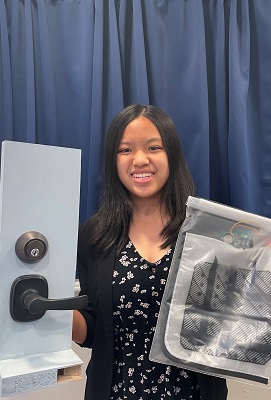
7th Grade, Stratford Middle School – San Jose
San Jose, California
Controlling Doors Using Interface Technology With Steps for People With Hand Disabilities (CONDUITS)
Project Background: “My grandfather had severe arthritis,” Jeanelle says. He struggled with opening doors, turning on faucets and doing other tasks with his hands. Millions of other people also have arthritis, carpal tunnel syndrome or other conditions that affect their hands. Jeanelle looked online for products to make it easier for those people to open doors. “I did not find any,” she says. So, she set out to invent a foot-controlled welcome mat to unlock doors. She wanted it to cost less than $100 and be compact. The device had to withstand moist conditions, be sensitive to weight and it had to unlock a door wirelessly at least 85 percent of the time.
Tactics and Results: Jeanelle’s first prototype checked the order in which nine buttons were pressed. That order was the password to unlock the door. Her second version checked how long someone pressed a button in a sequence. Her third version swapped out a Raspberry Pi microprocessor for an Arduino microcontroller. That change saved power. A breadboard for the device went inside a waterproof box. The device also had three light-emitting diodes, or LEDs, plus two batteries, a transmitter to send signals to the deadbolt, and a wire connecting it to a touchpad. For the fourth version, Jeanelle switched to a custom-printed circuit board. She also added a sleep mode to save more power. The device now could use smaller coin batteries, and it fit into a waterproof sleeve with a conductive-ink touchpad. Janelle tested each prototype with three trials of 50 attempts. Her fourth version had a 94 percent accuracy rate when given the correct number sequence, and it would not open the door when she used random numbers.
Other Interests: “I always make time for sports because of my firm belief in a strong and healthy body,” Janelle says. Her sports include fencing, swimming, soccer and Taekwondo. Janelle has also participated in speech and debate competitions, as well as theater. “I also love art and music,” she says. She sings and plays the ukulele and flute. She enjoys using digital lettering to display quotations in artistic ways. She hopes to become an aeronautical engineer.
Mina Fedor
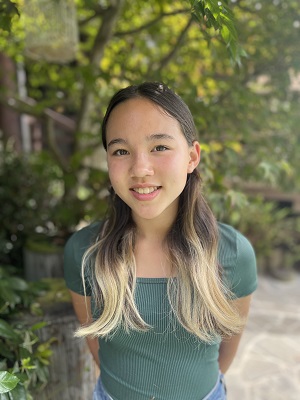
8th Grade, Black Pine Circle School
Berkeley, California
EEG Theta During Self-Directed Versus Passive Spatial Memory Encoding and Retrieval
Project Background: Online schooling during the COVID-19 pandemic got Mina thinking about how students learn. Sometimes students may use an active learning style. Basically, they are “more self-directed in organizing information,” she explains. At other times, students may learn more passively. A teacher might just present information to them, for example. Mina wondered which style was more effective. She also was curious about activity in the brain as learning happens. Research has linked certain types of brain rhythms to learning and memory. One of those patterns is known as the theta rhythm. “So, I thought to study the theta rhythm during active, self-directed learning versus passive learning,” Mina says.
Tactics and Results: Mina had learned about electroencephalography, or EEG, during a summer class. EEG can detect and measure Theta frequency rhythms in the brain. Measuring that rhythm during passive and self-directed learning could shed light on how the brain processes memories, she says. She recruited people for her study and attached EEG electrodes to their scalps. She told people to relax for three minutes. She measured their baseline Theta rhythms, and then gave people five minutes to organize ten random objects into a grid of their choice. She asked her test subjects to memorize the order. That was her active learning condition. Mina then asked those people to memorize the order of objects that were already in a grid pattern. That was her passive learning condition. People’s test results didn’t vary significantly between the two learning conditions, nor did Mina find a significant difference between the Theta activity for the two learning conditions. Her passive learning protocol might have affected the results, she suggests. Both learning conditions had more Theta activity than the non-learning baseline condition, though.
Other Interests: “Art is the way that I express myself creatively, and it centers me,” Mina says. She especially likes to draw and paint portraits. “They capture the likeness of someone filtered through my personal lens.” She swims, rows, fences and plays tennis. She also is active in politics. One big issue for her is getting schools to include history about Asian American and Pacific Islanders. “I want to be a teacher or a professor of neuroscience one day,” Mina says.
Victoria Harding Bradley
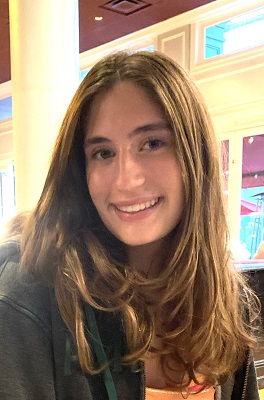
8th Grade, Nativity Catholic School
Menlo Park, California
Green Ears: A Study of Ultrasonic Acoustic Emissions in Response to Environmental Stressors in Plants
Project Background: “In California, where I live, vast amounts of water and pesticides are required to grow crops such as almonds and avocados,” Victoria says. As climate change continues, there will be more stress on water, land and other resources. “Making agriculture more efficient is an essential part of living with climate change,” she says. She had read about a lab study showing that tomato and tobacco plants emit ultrasonic sounds. The sounds were more frequent when the plants were stressed. Victoria wondered if such sounds could help farmers become more efficient at knowing whether plants were under stress. She also wondered if sounds could be detected from a mix of plants.
Tactics and Results: Victoria worked with garlic, cabbage, almond, strawberry, sage and tomato plants. A bat sonar detector let her “listen” to and record any sound signals from the plants. To test each species, she set up three soundproof boxes on top of beanbags. Each box had a plant and recorder inside. Victoria recorded each plant under normal conditions. She then tested whether sounds changed in response to drought, pruning, contaminated water, adverse sounds and bug attacks. In all, she made more than 1,000 hours of recordings. “With three in parallel, any sound recorded in just one box was coming from within that box,” she explains. But, “external sounds would be picked up by all three.” Sound processing software let her analyze the acoustic recordings. Plants’ acoustic profiles varied by species, she found. The rate and peak frequencies of plants’ sounds also increased in response to different stressors. “Ultimately, it might be possible to build a system which automatically alerts a farmer when plants react to stressors,” she says. That could help farmers save time and resources.
Other Interests: Victoria has been learning computer programming for the last several years. This summer, she used her skills on a project about video game avatars and body image. Victoria plays the viola and violin and sings in choir and she keeps active by playing volleyball. She has also enjoyed scouting and competing in academic decathlon with her school’s team. “I used to hate even the thought of blood,” Victoria says. Then she read about people who developed different surgical techniques for heart and circulatory problems. Now, she says, “I hope to pursue a career in cardiac surgery.”
Rory Hu
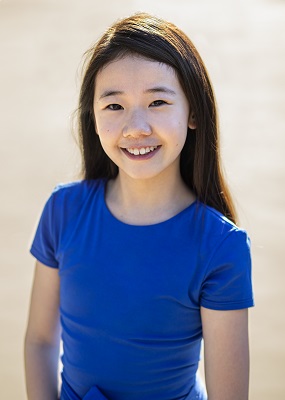
6th Grade, The Harker School
San Jose, California
The Effects of Pesticides, Caffeine and Tea Polyphenols on the Visual and Olfactory Learning and Memory of the Honey Bee
Project Background: Rory worries about dwindling honey bee populations. For one thing, her favorite breakfast is honey on toast. Beyond that, honey bees do important work as pollinators. “Without honey bees, the ecosystem would collapse,” she says. Research has linked certain pesticides to declines in the numbers of honey bees. The chemicals might impair the bees’ learning and memory skills. That could make it harder to find food and return to the hive. A recent study suggested chemicals in tea, called polyphenols, and caffeine might enhance honey bees’ learning ability and memory for smells. Might those chemicals also repair harm from the pesticides? Rory decided to find out.
Tactics and Results: Rory fed honey bees a sucrose solution while exposing them to a peppermint scent. Bees eat with their tongue-like proboscis. Rory judged if the bees linked the scent with feeding by whether they extended the proboscis during tests. She exposed some groups of bees to certain pesticides. Compared to a control group, those groups did worse on either learning or memory. Rory also fed tea polyphenols and caffeine to other groups of bees. and compared to the control group, their test results were better. Finally, she fed tea polyphenols and caffeine to some of the bees who had been exposed to pesticides. Rory found that their test results improved, and she also noticed that the bees seemed to remember the sight of a Q-tip. Her additional tests suggest the bees’ visual learning and memory is generally better than their learning and memory from smell. Bees didn’t do well at distinguishing Q-tip colors, though. Rory thinks beekeepers might use tea polyphenols and caffeine to help repair learning and memory damage from pesticides. She hopes “to help save the honey bee population, the ecosystem, and [her] breakfast!”
Other Interests: Rory has been a kid reporter for Nick News and Time for Kids. She also plays the piano, cello and violin and she sings in choir. “Becoming a software developer interests me because I enjoy coding, designing, and problem solving,” she says. She has taken coding lessons for two years so far. “As a software developer, I would be creating the future of the digital world,” she says.
Landon William Huber
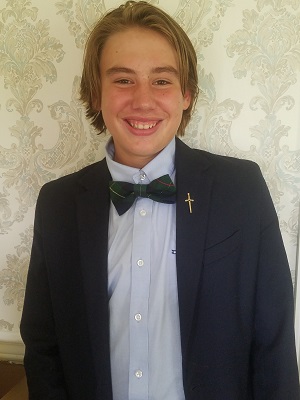
6th Grade, Christ Classical Academy
Tallahassee, Florida
Forged in Fire: Strength and Hardness of Metal
Project Background: “I became interested in blacksmithing after my dad and I started watching Forged in Fire,” Landon says. Blacksmiths on the television show compete against each other in making weapons. Landon then took a blacksmithing class at a museum. Quenching is part of the process for making weapons or metal tools. Quenching uses fluid to rapidly cool a material, such as a metal. The process helps to adjust different properties of the material. When Landon worked on hooks for his class, he used water to quench the metal. On the TV show, though, oil is the main quenching material. The difference made him curious: Which quenching materials make metal stronger and harder?
Tactics and Results: Landon got four samples of the same type of steel and heat treated each one in a forge at his home . He quenched each sample with a different fluid: brine, water, oil or air. Afterward, he took the samples to a college lab for testing. “Hardness is defined as the resistance to indentation,” he explains. The larger the indentation left by the diamond part on a testing machine, the softer the metal is. Steel treated with brine was the hardest. Then came steel treated by water, oil and air. He also used a tensile tester on parts of the sample. The machine applies increasing amounts of weight to a sample held with grips, and this provides information on the material’s strength and ductility. The oil-quenched steel had the highest tensile strength, which is how much strength a material can take before it fails and breaks. Water-quenched metal came in second, followed by brine-quenched steel and air-quenched steel was the weakest. This work matters because well-quenched metal is necessary for many uses. “The stronger the metal is, the longer it lasts.” Landon says.” This saves our limited resources.”
Other Interests: “One of my favorite extra-curricular activities is karate because I enjoy learning how to defend myself,” Landon says. His favorite team sports are football and baseball. He also enjoys camping with his Trail Life troop and he plays the guitar. His other hobbies include reading, chess club, fishing and more. He is interested in a career as an industrial engineer, “I am interested in working for the government and defense industry because I would like to help protect our country,” he says.
Skye Holyn Knox
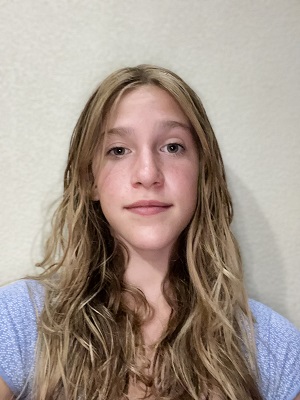
7th Grade, Pacific Crest Middle School
Bend, Oregon
Laboratory Testing of Chemical Cloud Seeding
Project Background: Cloud seeding is used in some places to induce rain or snow. In this technique, planes or aerial drones add chemical particles to clouds. Water droplets or snowflakes can then form around those particles, which leads to precipitation. There are open questions about cloud seeding, as well as various pros and cons. Some critics question the use of silver iodide for the cloud seeding particles. The chemical’s crystalline structure is similar to ice, which is a plus for cloud seeding. However, some critics wonder about possible toxicity if the chemical builds up in areas over time. Skye wanted to find out if other chemicals might be better alternatives.
Tactics and Results: Skye tested potassium iodide and silicon carbide to see if they might work for cloud seeding. The crystal structures of those chemicals are similar to silver iodide. A 2-liter bottle (just over half a gallon) was her cloud chamber. For starters, Skye wet the inside walls and added a milliliter (0.2 teaspoon) of water. She used a bicycle pump to increase the pressure to 206 kilopascals (almost 30 pounds per square inch). Skye’s testing rig held the bottle in place so it wouldn’t shoot off. When she released the pressure, vapor formed in the bottle. Skye measured the cloud density with a light sensor and light bulb. She then did tests with either 1 gram or 0.1 gram of each chemical. (One gram is 0.035 ounces.) Clouds formed with 1 gram of either chemical were not significantly denser than those made with plain water and plain water produced significantly denser clouds than her tests with 0.1 gram of either chemical. Skye might experiment with colder temperatures and uniform particle sizes in the future.
Other Interests: Skye enjoys creative activities, including art, music, writing and baking. “I also really enjoy running cross country,” she says. In her view, running “is a fun way to spend time with my family while training and gets me outside when I have been cooped up all day.” Her other sports include swimming and soccer. She hopes to become a physical therapist. “I would really like to be able to help adults and kids get back to doing what they love” after injuries, she says.
Mahi Kohli
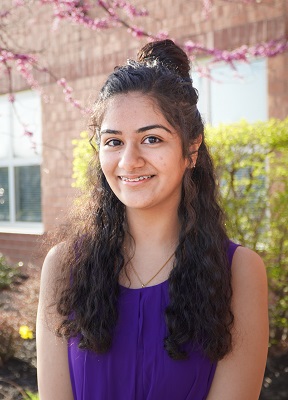
7th Grade, California Trail Middle School
Olathe, Kansas
Identifying Potential Alzheimer’s Biomarkers in Cerebrospinal Fluid
Project Background: Mahi used to visit an older woman named Rose at a nursing home, but Rose didn’t remember Mahi from week to week. Years later, Mahi learned about Alzheimer’s. The disease leads to memory lapses and other problems, and it kills roughly 122,000 Americans each year. When people have Alzheimer’s, different proteins build up in the brain. This build-up can lead to tangles within brain cells called neurons. The proteins also damage connections among neurons, cause eventual shrinkage of parts of the brain and cause other problems. Biological changes can begin up to a decade before people notice any symptoms, so Mahi wanted to find a way to diagnose the disease earlier.
Tactics and Results: Mahi wanted to see if there were significant differences in the proteins in fluids around the brain and spinal cord of Alzheimer’s patients, compared to healthy people. To find out, she used data from an earlier study. The data set gave information for 333 Alzheimer’s patients and healthy people, and it told the levels of 127 proteins in their cerebrospinal fluid. Mahi’s analysis showed that five proteins had significantly higher levels in Alzheimer’s patients than in healthy patients. Two other proteins had significantly lower levels in the Alzheimer’s patients. Mahi then tested two statistical models. Each model aimed to use a patient’s data to predict if they had Alzheimer’s. One model used variables known to be linked to the disease, including three of the seven proteins her analysis had found. That model was 72 percent accurate. Mahi’s second statistical model added in the four additional proteins she had identified. That model was 90 percent accurate in saying who did or didn’t have Alzheimer’s. Mahi hopes her work will help patients get an earlier diagnosis and better treatments.
Other Interests: “I listen to pop music — whether I’m taking walks, doing the laundry, or even sleeping!” Mahi says. Indeed, if she were making a time capsule, she’d include her Spotify playlists. She also likes reading stories with characters from Greek mythology. She’s also fascinated by mathematics in nature. This past year she was Kansas’s MATHCOUNTS state champion. She hopes to become a biologist.
Cooper Kroeker
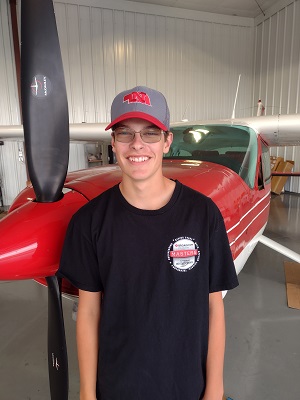
8th Grade, Perkins County Schools
Grant, Nebraska
Effects of Global Temperature Increase on Aviation
Project Background: “My parents and I farm,” Cooper says. “As farmers we get to see the impacts of climate change firsthand.” His family also has an airplane, and he plans to get a pilot’s license. He started wondering about how climate change will affect aviation. As temperature and distance above the ground increase, the density of the air decreases. “How does the temperature impact the density altitude?” Cooper asked. “And how does that impact takeoff distances?” The takeoff distance is how far a plane needs to run on the ground before it lifts off, plus the distance between that point and a certain altitude, such as 50 feet or 15 meters.
Tactics and Results: Cooper went to a nearby airport with his dad, and they took off on a variety of days with different temperatures. Each time, Cooper collected data, including the temperature, dew point, density altitude and more. Then he analyzed the data. “The results proved that temperature increase causes takeoff distances to increase,” he says. He also did research on representative airplanes at large cargo and passenger airports. He compared the takeoff distances to existing runways on a standard day. He also looked at the takeoff distances for the average daily high temperature for the hottest month. Using this data, he figured out what the distances would be for a day that was 5 degrees Fahrenheit warmer (roughly 2.8 degrees Celsius). “Airplanes will have to compensate for the higher temperatures,” he says. For example, the planes might need to take off at a higher speed. Or, they might need to limit their fuel or payload. Also, he adds, “Airports will have to compensate by building longer runways or limiting certain aircraft.”
Other Interests: “I am very interested in plants and gardening,” Cooper says. A career as a botanist could let him learn more about plants and perhaps help develop new hybrids, he thinks. He plays football and basketball, runs track and lifts weights in the summer. He plays the bassoon, saxophone and clarinet. He likes public speaking. “I also enjoy just building stuff,” he adds. Most times he makes something he needs. “But every once in a while, I’ll invent something new,” he says.
Alexander Montgomery
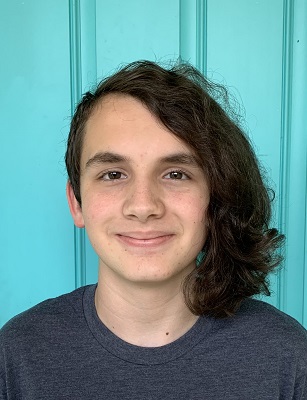
8th Grade, Andrew Jackson Middle School
Titusville, Florida
The Impact of Different Environmental Conditions on Galvanic Corrosion at Launchpad Structures
Project Background: “Galvanic corrosion is corrosion occurring between two different metals,” Lex says. The process can happen when different metals are in contact with each other in the presence of an electrolyte. Basically, one metal can snatch electrons from the second. So, the second metal corrodes faster than it would otherwise. Galvanic corrosion can be a problem at NASA’s launch sites, where environmental factors might promote the process. Among other things, daily condensation and rain regularly wet structures at launch pads. Salty seawater mist also settles on those structures and solid-state rocket boosters can release hydrochloric acid (HCl) onto metal structures. Lex wondered which of those factors most impacted the rate of galvanic corrosion.
Tactics and Results: Lex sandwiched together pre-drilled aluminum and steel panels to make his metal samples. He also dug through historic data to see how often structures at a typical Florida launch site would be exposed to precipitation, sea mist or fog, and acidic exhaust. He figured out a representative one-month standard for each factor. Then he worked out a spray schedule for three months. Based on his schedule, Lex sprayed different sets of his samples with distilled water, artificial seawater or a hydrochloric acid solution. Distilled water mimicked precipitation, the artificial seawater was a stand-in for sea mist or fog, and the acid represented acidic exhaust from rocket launches. All samples also got a daily water mist. That stood for condensation. After each month, Lex pulled some samples out and examined them. He looked at the percentage of corrosion on each panel. He also measured the density, depth and width of pitting. At first the acid was most corrosive. However, “the results showed that seawater mist is the most corrosive environmental variable over time,” Lex says.
Other Interests: Lex hopes to become a materials scientist. The field is relevant to a wide range of topics. He also likes the broad possibilities for jobs in the field. “For example, you could be working with a structural engineer in a construction company on what metals to use in a bridge and how to protect them. Or, you could work for NASA and study corrosion on almost every structure and help prevent it,” he says. Lex is active in art club, science club and science/math Olympiad. He has also attended NASA Space Camp.
Kasey Moore
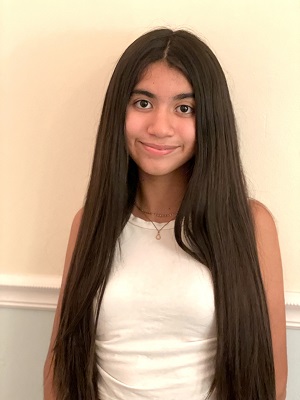
7th Grade, American Heritage School
Delray Beach, Florida
The Effect of Uncaria tomentosa (Cat’s Claw) in Learning and Memory in Lymnaea Stagnalis (The Great Pond Snail)
Project Background: A few years ago, Kasey’s grandmother was diagnosed with Alzheimer’s disease. Over time, the brain disorder causes people’s memory, thinking and social skills to decline. “I saw how devastating this disease was, not only for my grandma but for the whole family,” Kasey says. Members of her family are from Peru. She had heard them talking about a plant that grows there, called cat’s claw. Some companies sell it as a supplement to enhance memory and for other purposes, so Kasey wanted to find out more. She decided to work with a pond snail known as Lymnaea stagnalis. Scientists have used the snail as a model animal in other studies to learn more about memory, learning and diseases of the brain.
Tactics and Results: Kasey divided 30 snails into two groups of 15. First, she exposed each group to the sweet taste of sucrose, which stimulates the appetite. Then she counted how many bites per minute each snail took. The mean number of bites per minute didn’t differ significantly for the two groups. Training came next. Kasey used a process called conditioned taste aversion or CTA, to train the snails and then tested their learning and memory. The training exposed the snails to the appetite stimulus. But then came a bitter taste, which is an aversive stimulus. The control group of snails was trained in plain pond water. The test group was trained in a solution of 0.1 percent cat’s claw. Kasey counted the snails’ bites per minute after 10 minutes, an hour and 24 hours. Those intervals represented short-term, intermediate and long-term memory. At each time interval, the average number of bites per minutes was lower for the snails trained in the cat’s claw solution. The results support the hypothesis that cat’s claw helped the snails learn, form and retain new memories, Kasey says.
Other Interests: “The piano and violin help me to relax, and release all my feelings into the songs I play,” Kasey says. Two years ago, she organized an online fundraiser for the Parkinson’s Foundation, which she called Parkin-SONG. She enjoys playing tennis for exercise and has fun in science and math competitions, too. “My future goal is to become a neurosurgeon and researcher to study and decode the mysteries of the human brain,” Kasey says.
Luka Anthony Nguyen
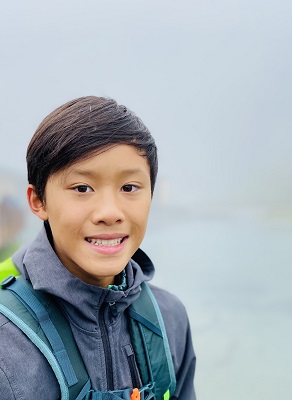
7th Grade, Challenger School – Silverado
Las Vegas, Nevada
Which Mangroves (Mature Plants vs. Immature Propagules) Thrive Better and Are Best Suited for Aerial Reforestation?
Project Background: Several years ago, Luka went to Bali in Indonesia. In the same year, an earthquake and related ocean surges caused widespread destruction. Yet mangroves protected some parts of the island. These trees shelter ecosystems and also absorb carbon. Though Indonesia and some other areas have sadly lost a large share of their mangrove trees, reforestation work with drone aircraft might help. “I wanted to determine which mangrove propagules were the best candidates,” Luka says. Propagules are seeds, runners and other plant structures that grow into new plants.
Tactics and Results: Luka wanted to know whether immature seedlings or more mature plants might survive aerial reforestation better. To learn more, he experimented with three saltwater aquariums. He colonized each tank with bacteria that produce nitrates. He also regularly added fish food during the experiment. Luka introduced immature red mangrove seedlings with no roots or leaves to one of the tanks. A second tank got an equal amount by weight of young mangroves with a few leaves and roots. The third tank did not get any mangroves. Mangroves naturally remove nitrates from saltwater, so, Luka used the tanks’ nitrate levels to gauge the well-being and survival prospects for his mangroves. “The immature propagules clearly had the edge,” he says. Their tank showed the largest drop in nitrate levels over the course of two weeks. Only 20 percent of the young mangroves with leaves and roots survived, and their tank showed a smaller reduction in nitrate levels. There was minimal change for the control tank. “Understanding which mangroves survived best would help guide future replanting efforts,” Luka notes.
Other Interests: “With 3D Printing, I have embraced the philosophy of being a maker, creating rather than consuming,” Luka says. He started a 3D printing class at his local library and helped raise money for a 3D printer for a school in Nigeria. Luka enjoys swimming, snowboarding and kayak fishing. He’s active in scouting and he plays the cello and piano. “After completing this mangrove project, I became interested in a career in environmental engineering.”
Sritej Sai Padmanabhan
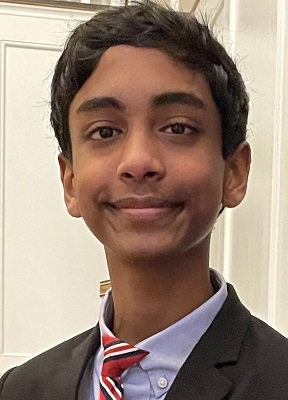
8th Grade, Marshall Middle School
Wexford, Pennsylvania
Can Video Analysis of Hand Tremors Aid in Telehealth?
Project Background: Sritej’s grandpa has Parkinson’s, a disease of the brain and nervous system. One of its symptoms is hand tremors and it also causes problems with movement, memory and mood. When Sritej’s grandfather travelled, his doctor back home couldn’t monitor his hand tremors. Sritej wanted to find a way to do that. A method using video could help with remote telehealth visits, he reasons. He also wanted his method to be quantitative. In other words, it would be based on objective measurements rather than subjective judgments. That way, doctors could track gradual changes they might not notice otherwise. Doctors could then adjust people’s medicines or take other steps to help.
Tactics and Results: Sritej developed a way to analyze hand tremors with smartphones, videos and a computer. “I recorded 25 videos of simulated hand tremors from four family members,” he says. He then used Python code and open source software libraries to analyze the videos. Together, the platforms let him store videos and frame hand models. One platform also could use machine learning to track finger movements. Sritej’s system could then use data from the platforms to calculate the frequency of hand tremors in the videos. When Sritej had filmed the hand tremor videos, each person in those videos also wore a smartphone strapped to their wrist. The phones have devices called accelerometers, which measure vibrations or changes in the rate of movement. Those data let Sritej record the actual frequency of each person’s hand tremors. The results calculated by his video analysis program were within 10 percent of the actual frequencies measured with data from the smartphones. Video analysis can provide accurate and reliable measures of hand tremors, he concludes.
Other Interests: “Outside of school, I enjoy participating in competitive robotics tournaments,” Sritej says. He also plays chess and golfs. “Golfing involves an immense amount of focus and perseverance,” he says. He plays the flute and takes part in other school activities. Sritej also takes part in community service activities, such as organizing senior center visits and serving in soup kitchens. He hopes to become a neurologist so he can help find cures or treatments for people with disorders such as Parkinson’s and Alzheimer’s.
Moitri Santra
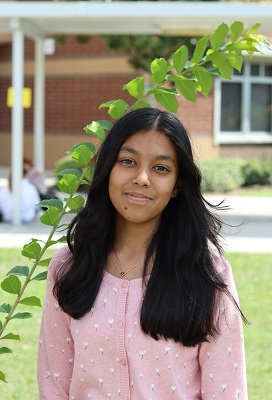
8th Grade, Jackson Heights Middle School
Oviedo, Florida
Innovative Engineering Tools for Controlling Harmful Algal Bloom (HAB): Year 3
Project Background: Harmful algal blooms (HABs) happen when excess nutrients in the water and other conditions let certain species grow out of control. Some species involved in HABs can release toxins and present health risks. Tourism, fishing and other industries can also suffer from HABs. Moitri studied existing solutions for the problem in a previous science project and different approaches had drawbacks, she found. Last year, she developed a novel gel that made algae clot and sink in water, where it would die. However, too much decomposing algae in lower levels of water can deplete the oxygen supply. The resulting “dead zone” can then harm species that normally live there, so Moitri decided to see if she could harvest algae instead.
Tactics and Results: Moitri wanted to reduce the problem of harmful algal blooms and reduce the risk of making dead zones worse. Her solution uses positively charged, microfiber-based materials to harvest material from blooms. A robot system would deploy spools of the material in water and bring them back. The harvested algae might then be used to make biofuels, she says. Moitri tested different concentrations of two gel formulas on two types of algae. She dried the gel into a film and put it on a water surface with algae on it. The gel made algae in the water clump together. Moitri then coated sponges and non-woven materials with gels and tested how well they did at collecting the algae. In the end, the most practical approach used a non-woven fiber with a chitosan-citric acid gel. She also designed a robot system, called SCARAB. Its job would be to deploy spools of the gel-coated material in water to collect algae and then bring the spools back. Tests with a prototype worked well and the non-woven strips could also be reused.
Other Interests: “Music has always appealed to me as a way of expressing myself,” says Moitri. She plays the piano and sings, and her tastes run from pop music to classical. She also enjoys scouting, as well as robotics competitions. Her favorite sports include running, tennis and softball. Softball “has taught me the importance of team strategy and assessing opponents’ strengths and weaknesses,” she says. Moitri hopes to become a computer scientist.
Sanjan Singh Sarang
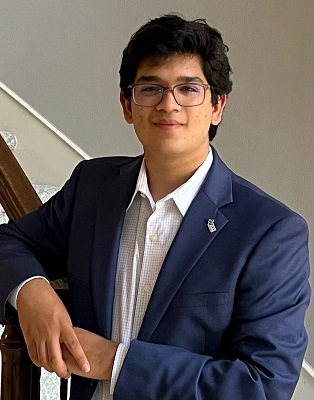
8th Grade, McCullough Junior High School
The Woodlands, Texas
Testing the Impact of Food Ingredients, Consumer Products and Their Packaging on the Human Endocrine System
Project Background: Some chemicals in foods and consumer products can mess with the body’s endocrine system, which produces chemicals called hormones. Hormones help regulate a wide range of functions in the body, but some disruptor chemicals can bind to receptors for different hormones. The disruptors can then throw the system out of whack. Sanjan wanted to see if certain quantitative models could flag some chemicals in consumer products as possible disruptors. He focused on chemicals that might mess with receptors for estrogen and thyroid. Estrogen is a sex hormone and is important for people’s bone health, the circulatory system, brain function and more. Thyroid hormones regulate the body’s metabolism and play roles in growth and development.
Tactics and Results: Sanjan used computer analysis tools known as QSAR models. The letters stand for Quantitative Structure-Activity Relationships. The models look for links between aspects of different molecules’ chemistry and their effects on the body. If the models find a correlation, they might then make predictions about other chemicals with similar features. Sanjan did research on multiple websites to find chemicals that might bind with certain estrogen or thyroid receptors. He chose nine chemicals to test with the models. For controls, he chose an additional three chemicals that are known to work like hormones. One chemical, for example, is a thyroid supplement. Sanjan then looked up information about the 12 chemicals’ makeup and structure. He entered the data into the models and found some patterns. For example, some of the chemicals were strong or very strong binders for an estrogen receptor. From that, Sanjan expects that “all chemicals in the soy isoflavone group are estrogen binders.” He also found data gaps where more research is needed. Ultimately, the work could help limit people’s exposures to harmful chemicals.
Other Interests: Sanjan enjoys playing tennis and basketball, reading and tinkering with robotics and other technology. He also plays the bassoon, clarinet and piano. “Playing bassoon shows the musical and calm side of my personality,” he says. Sanjan also volunteers at a local food bank. He hopes to become a medical doctor because working in the medical field will let him help people avoid illness, he says.
Mona Sophie Schwickert
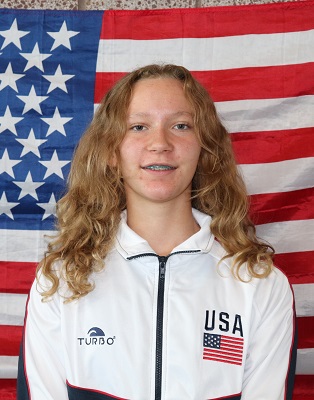
7th Grade, Arizona Virtual Academy
Glendale, Arizona
Sun Lotions and Bathing Suit Straps: The Impact Sun Lotions Have on Bathing Suit Straps’ Elasticity
Project Background: As a synchronized swimmer, Mona spends lots of time in outdoor pools. At home, she usually uses a homemade zinc oxide sunscreen lotion. Mona doesn’t spray it on, and she did not notice any problems with her bathing suit straps when she used it. Sometimes at competitions, however, she borrowed her friends’ spray-on sunscreens. After using aerosol sunscreens several times, Mona noticed her bathing suit straps were less elastic. “At some point the straps got so stiff that I had to ask my parents to buy me a new black suit,” she says. She wondered if the aerosol sunscreens were to blame.
Tactics and Results: Mona soaked bathing suit straps in mixtures of different sunscreen lotions. Some were mineral sun blockers, while others were chemical sun lotions. Some were spray-on lotions, while others were not. After soaking, each strap was stretched on a testing rig. Mona made the rig with wood, screws, clamps, a computer and an Arduino, which is a programmable circuit board. Measurements from the rig let her calculate how elastic each strap was. Mona also soaked straps in mixtures of sunscreen and a bleach solution that was like pool water. She then calculated the elasticity of the straps after those soakings. She also tested straps that weren’t soaked in lotion or in chlorine, as controls. She found that straps soaked in two types of aerosol sun lotions were less elastic than those soaked in non-aerosol lotions, and straps soaked in those two aerosol sun lotions with chlorine were the least elastic. Aerosol sun lotions use propellants, such as iso-butane and dimethyl ether, Mona explains. The chemicals cause swelling in plastics like those the straps are made from, she reports. The propellants can react with chlorine to make an acid; that also could reduce the straps’ elasticity, she adds
Other Interests: Mona was on the 13-15 National Team for USA Artistic Swimming this year. “I enjoy this sport because I can swim to music and be part of a team,” she says. She hopes to compete in the Olympics in 2028. She also enjoys crocheting animals, such as a blue dart frog and red tiger. Mona hopes to become an environmental engineer. She worked with her school’s Future City team this past year to design a waste-free city.
Elizabeth Shen

7th Grade, Davis Drive Middle School
Cary, North Carolina
Flower Petal-Inspired Computer Memory Leveling via the Golden Ratio
Project Background: Computers don’t enter data into memory evenly. Over time, too many heavily used cells get damaged, and the memory must be replaced. Managing memory better could even out its wear and reduce waste. Several years ago, Elizabeth learned about the golden ratio in art class. If two numbers have the golden ratio, the sum of both numbers divided by the larger one equals the larger number divided by the smaller one. Many people find the proportions pleasing in art. The golden ratio also shows up in nature. An example is how many flowers grow new petals roughly 137.5 degrees from the last one. Elizabeth wondered if the concept might help even out the use of a computer’s memory.
Tactics and Results: Elizabeth’s approach to leveling out wear on a computer’s memory treats its two halves as if they were two rings. The rings take turns as working memory. When one ring is the working memory, “all the useful data on the other ring is copied to it,” she explains. The starting point for copying is 137 degrees away from the point used when the last working period began. “By shifting the location of data in a way similar to how flower petals are placed, the accesses and hence wear of the memory cells are evened out,” she explains. She combined the approach with an existing process for “garbage collection.” That process gets rid of data and code that are no longer needed. It also helped her system rearrange data in order and avoid extra processing time. Elizabeth ran seven common programs and used memory traces to test her golden ratio method, as well as a variation and the computer’s default approach. On average, her method accessed memory cells the lowest number of times.
Other Interests: “Horse riding has always held a place in my life,” Elizabeth says. She finds the sport relaxing. More than anything else, riding has taught her “how to fall and how to get back up each time,” she adds. She also enjoys swimming and sings and plays the piano and flute as well. Elizabeth is interested in a career as an astronomer. “It’s easy to forget the sheer scale of not just this world, but the universe as a whole,” she says.
Ethan Benjamin Shlossberg
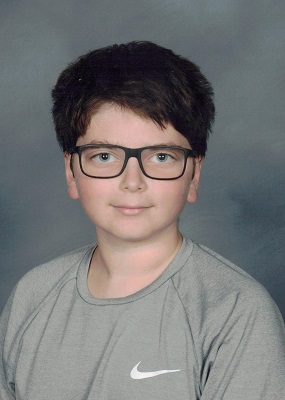
8th Grade, Holicong Middle School
Doylestown, Pennsylvania
Quail Egg Patterns: Unique to a Quail?
Project Background: A friend of Ethan’s family keeps quail in pens at his farm. The family friend wanted to know which birds were laying the largest eggs in each pen but he didn’t want to separate the quail for long periods of time. “I thought of the theory that each quail has its own egg pattern,” Ethan says. The eggs of many types of birds look identical but that’s not true for quail. “I am passionate about coding,” Ethan says. He’s especially fascinated by artificial intelligence, or AI. He wondered if he could use AI to distinguish different quail egg patterns. If so, the work could also test if quail indeed have unique egg patterns. It could also tell farmers which quail laid which egg.
Tactics and Results: “I realized a machine learning software, such as Amazon Rekognition, would be an ideal tool to pattern match,” Ethan says. First, he put individual quail alone in cages until each bird laid at least five eggs. He labeled the eggs and photographed each egg all around. He fed images of five eggs for each bird into the program to train it. He then used other images of quail eggs to test the model. “The model tries to guess which quail laid which test egg based on the training data,” Ethan explains. Tests with groups of three and six eggs had good results. Ethan therefore concluded that a quail can be identified based on its egg pattern. “This is ideal, as quail are kept in groups of three to six,” he notes. Farmers could use the approach to figure out which quail are laying the most and largest eggs. “Ultimately, farmers can use this data to selectively breed the birds to obtain better quail,” he adds.
Other Interests: “The hobby I most enjoy is playing Dungeons & Dragons with friends,” Ethan says. He particularly likes the role of dungeon master. Ethan sings with a choir and plays the cello and he stays active by running, playing tennis and practicing Taekwondo. His other activities include computer club, robotics, scouting and more. Ethan hopes to become a zoologist, and especially wants to help protect endangered species. “Wildlife needs an advocate now, more than ever,” he says.
Aryaman Dixit Shukla
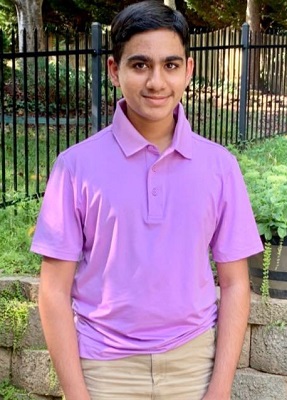
8th Grade, Hanes Magnet Middle School
Winston-Salem, North Carolina
Repurposed Harmful Algal Bloom (HAB) Leaf Mulch Pellets
Project Background: For an earlier project, Aryaman made pellets from leaf mulch to help lawns retain moisture during drought periods. This year, he wanted to make pellets that could hold in moisture and also add nutrients for the lawn. To do that, he decided to add two types of organic waste to his leaf mulch pellets. One of those types is wood ash. The other is harvested material from harmful algal blooms, or HABs. HABs happen when pollution from too many nutrients and other conditions let algae or cyanobacteria (also called blue-green algae) grow out of control in lakes or other water bodies.
Tactics and Results: Aryaman collected material from algal blooms in stagnant ponds. He dried that material in the sun to break down a toxin, which some blue-green algae can produce. He combined eight parts of ground dried leaves with one part each of wood ash and dried HAB material. He added that mix to a rice starch solution. Then he baked it in tiny molds on low heat. Aryaman applied some of the HAB pellets to two pots of grass. He used a second batch of pellets with no HAB material or wood ash for two other pots of grass. Another two pots of grass did not get any added pellets. Aryaman took care of the grass and sampled the pots’ soil over the course of six weeks. Levels of nitrogen and phosphorus in soil for the grass treated with the HAB pellets were one to four times as much as for the untreated pots. The levels for pots that got the HAB pellets were also more than twice those for pots with plain leaf mulch pellets. Using the pellets can save money on water and fertilizers for lawns, Aryaman says.
Other Interests: “In so many ways, music defines who I am,” Aryaman says. He plays the clarinet, oboe, alto-saxophone and piano. And his musical talents have won awards at the state and district level. He stays active by running, swimming, playing tennis and practicing Taekwondo. He enjoys mentoring other students in math. He also volunteers for a variety of causes. He hopes to become a neurologist one day. He’s particularly interested in learning more about factors that lead to cognitive decline. “My goal is to add quality to longevity,” he says.
Emma Abigail Simmons
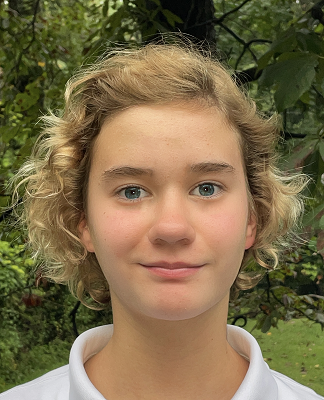
7th Grade, Mother Seton School
Emmitsburg, Maryland
Portable Bronchodilator Delivery System for Equine Inflammatory Respiratory Diseases
Project Background: “My twin sister and I are equestrians, and we ride a 17-year-old thoroughbred,” Emma says. “I found out a year ago that my horse has asthma. I could see him struggling to breathe sometimes when we rode.” Asthma is a chronic disease of the body’s airways. During attacks, the airways can become inflamed and narrow. The sisters worried what would happen if the horse had a bad asthma attack when they were out riding. Long-term use of injections can make a horse go lame. Nebulizers are another option but, Emma says, “most horses do not like wearing the face mask.” Together the sisters invented a portable delivery system that lets a rider give a horse its asthma medicine.
Tactics and Results: “With our invention, medications can be given to asthmatic horses without returning to the stable, or even leaving the horse’s back,” Emma says. The team’s design uses a bicycle hand pump, tubing, and a nebulizer cup. A nebulizer is a device that makes a fine spray of liquid. The girls used water, but in the field, that would be a liquid asthma medicine for the horse. Working the pump compresses air and forces it through a tube to the cup. A baffle makes the air entering the cup swirl around. The force and energy of the moving air make a mist from the liquid. The mist is propelled from the cup through more tubing. That tubing leads up near the horse’s nostril and the animal breathes in the liquid. The team tried out different types of pumps and tubing, then built a prototype. They tested the prototype on a model horse and then on a real horse. The prototype worked well and “did not restrict the horse’s movement,” Emma says.
Other Interests: Emma enjoys drawing, reading, writing and singing. She enjoys playing tennis, swimming, and playing musical instruments like the piano, guitar, and saxophone. Her other activities include science club, safety patrol and yearbook. But her most favorite activity is horseback riding. “I love the feeling of the horse moving and the sound of the horse’s hooves,” she says. “I want to be a veterinarian and develop ways to improve the lives of horses that have respiratory diseases,” she adds.
Sarah Charlotte Simmons
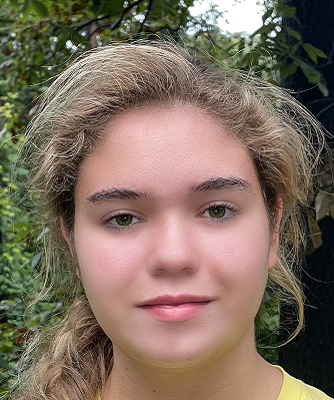
7th Grade, Mother Seton School
Emmitsburg, Maryland
Portable Bronchodilator Delivery System for Equine Inflammatory Respiratory Diseases
Project Background: Sarah and her twin sister Emma ride horses. “Recently, we noticed that one of our horses had difficulty breathing after a long ride,” Sarah says. “Our riding coach said the horse has asthma.” Asthma, a chronic disease of the body’s airways, is a disease that both horses and humans can have. During asthma attacks, the airways can become inflamed and narrow. Sarah worried about what could happen if a horse had a severe asthma attack when she was out riding. “It’s not always possible to return to the barn quickly or to safely dismount and then remount,” she says. The sisters learned about different ways to treat a horse’s asthma attack, including injections and nebulizers with masks. However, both have drawbacks.
Tactics and Results: “Our invention enables a rider to administer asthma medicine manually while remaining mounted,” Sarah says. The team’s design uses a bicycle hand pump, tubing, and a nebulizer cup. A nebulizer is a device that makes a fine spray of liquid. The girls used water during testing, but in the field, that would be a liquid asthma medicine for the horse. Working the pump compresses air and forces it through a tube to the cup. A baffle makes the air entering the cup swirl around. The force and energy of the moving air make a mist from the liquid. The mist is propelled from the cup through more tubing. That tubing leads up near the horse’s nostril and the animal breathes in the liquid. The team tried out different types of pumps and tubing, then they built a prototype. They tested the prototype on a model horse and then on a real horse. “We found that a mounted rider could effectively engage the pump and dispense the medicine,” Sarah says.
Other Interests: Sarah is passionate about horseback riding. “When I’m riding, I feel so free and confident, like I can take on the world,” she says. “I also love to sketch,” she adds. Her other activities include science club, safety patrol and yearbook. She also plays the piano and saxophone and sings in choir. “I want to be either an aeronautical engineer or biomedical engineer when I get older,” Sarah says.
Kai Unwin-Wisnosky
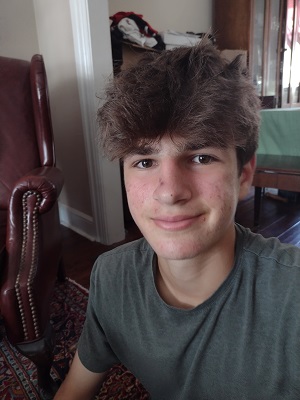
8th Grade, University Scholars, Pennsylvania Leadership Charter School
West Chester, Pennsylvania
Are Four Scaled-Down Savonius Vertical-Axis Wind Turbines More Efficient Than a Single-Scaled Wind Turbine of the Same Type?
Project Background: Last year, Kai worked with a Savonius vertical-axis wind turbine. As wind hits aerofoils on the turbine, they rotate. The turbine converts that energy into electricity. Kai was very interested in wind power. But, he says, “it needs constant wind to produce electricity consistently.” Last summer, he went to the beach and noticed it was almost always windy there. He thought the vertical-axis wind turbine he had experimented with before could work well for coastal areas. He started looking into the benefits and differences of vertical wind turbines versus horizontal ones. He also wondered about the wake effect of wind turbines, which refers to a small drop in the wind’s energy just downstream from a wind turbine.
Tactics and Results: Kai tested whether a single vertical-axis wind turbine would be more efficient than a set of four that was scaled down. The four scaled-down turbines had a similar design and took up the same amount of space. Kai designed and built models for each setup. Then he used a leaf blower as wind to test each arrangement 15 times. He kept the speed constant and measured the optimal electrical output for each turbine in the four-turbine setup. “The four-turbine setup produced more electricity than the single turbine setup,” Kai reports. That wasn’t what he had thought would happen. Angular momentum and drag might have affected the efficiency more than friction or the wake effect, he suggests. This work could help in the transition to clean energy. Smaller vertical turbines might help in residential areas where large turbines aren’t allowed, he suggests. “My setup is more fit for individual use on coasts,” he adds. There, “it can handle high speeds without breaking, allowing it to create backup power generation during storms.”
Other Interests: “I enjoy playing soccer the most because it keeps me healthy and helps me make friends,” Kai says. He plays the piano and trumpet and also enjoys community service. One example is holiday gift wrapping to help a group for people with disabilities. He hopes to become a mechanical engineer. “I enjoy the design process and finding answers to problems,” he says. The career also would allow him to do more work in the renewable energy field.
James Xiao
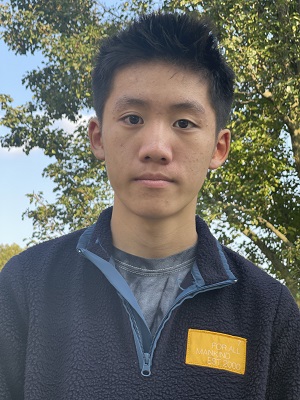
8th Grade, Marshall Middle School
Wexford, Pennsylvania
The Role of Gut Bacterial Metabolome in Colorectal Cancer (CRC)
Project Background: One of James’ favorite actors was Chadwick Boseman. The actor died from colorectal cancer, or CRC, in 2020. James set out to learn more about the disease. Along the way, he found research suggesting links between that type of cancer and the gut microbiome. The gut is the body’s gastrointestinal system, and the gut microbiome is the community of microorganisms living there. It includes many types of bacteria, plus some other organisms. James had learned that the gut microbiome can affect various aspects of health. He wanted to see how chemicals produced by some of the gut’s bacteria, called metabolites, might affect the growth of CRC cells.
Tactics and Results: James worked with four types of bacteria that other research had linked to risks for colorectal cancer. After he grew them in separate solutions, he spun the solutions in a machine called a centrifuge. The bacterial cells separated and sunk to the bottom. The liquid at the top contained the chemicals those cells had secreted as a result of their metabolic processes, called metabolites. James added different concentrations of the top-floated liquids to cultures of CRC cells. After two days, he used a lab machine to count the change in the number of cells for each sample. The number of cancer cells “dramatically decreased” in samples that had top-floated liquid from two of the bacteria types. Additional work let James look at the levels of different metabolites in the top-floated liquids. He found higher amounts of a chemical called ciliatine in the liquids that seemed to inhibit cancer cells. Ciliatine was either absent or present in normal, lower amounts in the liquid from the other two bacteria types. James thinks further work could help lead to new treatments for CRC.
Other Interests: “One of the hobbies that I enjoy the most is chess,” James says. He likes thinking through the different moves and going to tournaments. He stays active with tennis, swimming and soccer, and he also plays the violin. “In the future, I would like to pursue a career in medicine,” James says. He is especially interested in research in the field of biotechnology. He also hopes to combine skills from biology and computer coding to design robots and programs that can improve people’s health.
Ethan Yan
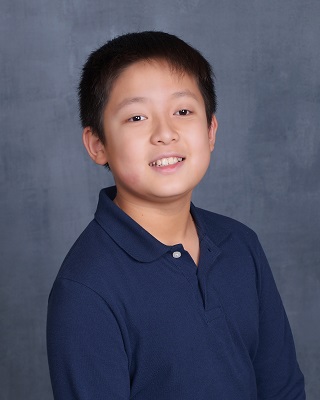
7th Grade, Burlingame Intermediate School
Burlingame, California
Can “One Look” by Machine Detect Acute Leukemia? Classic and Novel Deep Learning-Based Detection Systems for Leukemia
Project Background: About a year ago, Ethan’s aunt learned she had acute leukemia. Patients with that blood cancer need aggressive, timely treatment. But, he says, “it took weeks for her to get diagnosed and start treatment.” At the time, Ethan was learning about artificial intelligence, or AI. “I started to wonder if I can build an AI model to detect leukemia,” he says. YOLOv4 (for “You Only Look Once”) is a fairly new one-stage object detection model. To his knowledge, it hadn’t been used yet to detect leukemia cells. Ethan also wanted to see what he could do with a type of neural network known as CNN. That stands for Convolutional Neural Network, and it’s often used to process pixel data in images.
Tactics and Results: Ethan got digital images for 4,000 leukemia cells and 14,000 normal white blood cells from an online public archive. He converted the images to the proper formats for both CNN and YOLOv4. He entered the appropriate settings for each model, then used about 70 percent of the digital images to train each AI tool. The training taught the models to classify leukemia cells and tell them apart from healthy white blood cells. Ethan used the remaining images to test and improve each model. “Finally, I evaluated both models,” he says. He considered the pros and cons of each model. He also weighed the models’ performance, their training time, the potential for clinical application, and other factors. Both models identified leukemia cells with more than 90 percent accuracy. The YOLOv4 model could also perform localization, Ethan notes. So, it might be able to find cancer cells in blood smears, rather than just identifying them from images of single cells. That could be helpful for clinical settings.
Other Interests: Ethan plays the piano, saxophone and double bass. “I love the different sounds each instrument makes and the different story each music piece tells,” he says. He stays active with baseball, swimming and karate. He also started his school’s science club. Ethan enjoys computer science and hopes to become a medical doctor one day. “I want to be a doctor who not only knows how to treat diseases but also knows how to code and do research,” he says.
